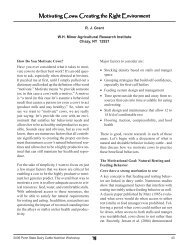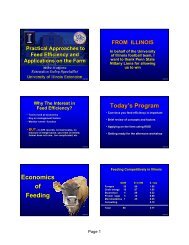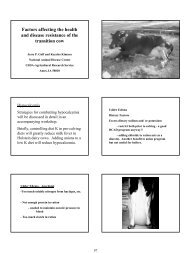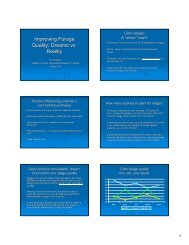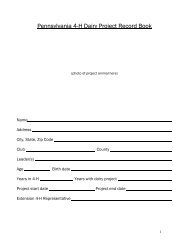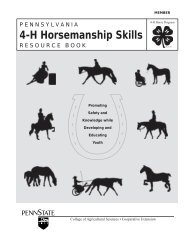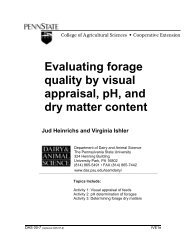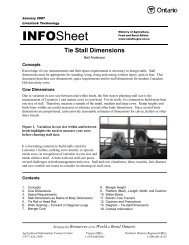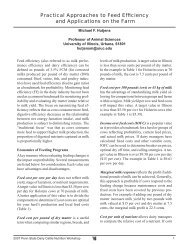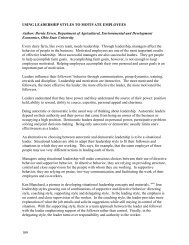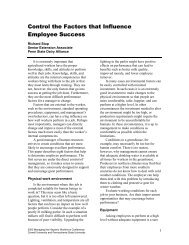DETERMINING THE MINERAL REQUIREMENT OF DAIRY CATTLE
DETERMINING THE MINERAL REQUIREMENT OF DAIRY CATTLE
DETERMINING THE MINERAL REQUIREMENT OF DAIRY CATTLE
Create successful ePaper yourself
Turn your PDF publications into a flip-book with our unique Google optimized e-Paper software.
<strong>DETERMINING</strong> <strong>THE</strong> <strong>MINERAL</strong> <strong>REQUIREMENT</strong> <strong>OF</strong> <strong>DAIRY</strong> <strong>CATTLE</strong><br />
Jesse P. Goff<br />
Metabolic Diseases and Immunology Unit<br />
National Animal Disease Center<br />
USDA-Agricultural Research Service<br />
Ames, IA 50010<br />
These notes will not deal with the physiological function of the minerals but will deal with<br />
meeting the dietary requirements. Certain aspects unique to dairy will be discussed as well<br />
as physiological factors affecting absorption.<br />
Dietary Requirements - The Factorial Approach<br />
When possible the requirement of the tissue for each mineral will be discussed. The<br />
dietary requirement is dependent on the amount of dietary mineral that is absorbed into the<br />
tissues. This means that if we can determine the requirement for maintenance<br />
(endogenous fecal loss and urine loss), pregnancy (fetus plus placenta), lactation (milk<br />
content), and growth (mineral content of the tissue gained) we can determine the tissue<br />
needs. If we know the fraction of dietary mineral absorbed from the diet the requirement of<br />
the cow can be described by:<br />
Dietary Requirement = Maintenance + Pregnancy + Growth + Lactation<br />
Absorption co-efficient<br />
The values used for maintenance, pregnancy, growth , and lactation are those used in<br />
either the 1980 Agricultural Research Council’s Nutrient Requirements of Ruminant<br />
Livestock or the 1989 National Research Council’s Nutrient Requirements of Dairy Cattle.<br />
These values vary little and really are readily measured and pretty reliable.<br />
The real challenge is to determine the co-efficient of absorption for the minerals across a<br />
wide variety of diets and/ or supplemental sources. Those factors affecting this number will<br />
be described as much as possible so that you can use reasonable judgment to decide<br />
when you are dealing with a situation that calls for more or less mineral than standard texts<br />
on mineral nutrition would suggest. An excellent reference to assist in deciding relative<br />
bioavailability of minerals from feedstuffs and supplements is Bioavailability of nutrients for<br />
animals. edited by C. Ammerman, D. Baker and A. Lewis.<br />
This is followed by a section on diagnostic aids to help you decide when a mineral problem<br />
exists. An excellent resource for diagnostic evaluation of mineral deficiencies is Mineral<br />
Levels in Animal Health, by R. Puls.<br />
Calcium (Ca)<br />
Since Ca is so essential for life vertebrates have evolved an elaborate system to<br />
maintain Ca homeostasis. This system attempts to maintain extracellular Ca concentration<br />
constant by increasing Ca entry into the extracellular fluids whenever there is a loss of Ca<br />
from the extracellular compartment. When Ca loss exceeds entry hypocalcemia can occur.<br />
If Ca enters the extracellular compartment faster than it leaves hypercalcemia can occur<br />
which can lead to soft tissue deposition of Ca.<br />
Ca leaves the extracellular fluids during bone formation, as digestive secretions,<br />
sweat, and urine. An especially large loss of Ca to milk occurs during lactation. Ca lost via<br />
35
these routes can be replaced from dietary Ca, from resorption of Ca stored in bone, or by<br />
resorbing a larger portion of the Ca filtered across the renal glomerulus, i.e. reducing<br />
urinary Ca loss.<br />
Ultimately dietary Ca must enter the extracellular fluids to permit optimal performance<br />
of the animal. Ca absorption can occur by passive transport between epithelial cells<br />
across any portion of the digestive tract whenever ionized Ca in the digestive fluids directly<br />
over the mucosa exceeds 6 mM. These concentrations are commonly reached when<br />
young animals are fed milk. In non-ruminant species, studies suggest that as much as<br />
50% of dietary Ca absorption can be passive. It is unknown how much passive absorption<br />
of Ca occurs from the diets typically fed ruminants but the diluting effect of the rumen<br />
would likely reduce the degree to which passive Ca absorption would occur.<br />
Active transport of Ca is the second route for Ca absorption, and is especially<br />
important when diets are not high in Ca. Active transport of Ca is controlled by 1,25dihydroxyvitamin<br />
D, the hormone derived from vitamin D. Vitamin D, produced within the<br />
skin or provided in the diet, is converted to 25-hydroxyvitamin D in the liver and can be<br />
further metabolized to 1,25-dihydroxyvitamin D in the kidneys. Parathyroid hormone<br />
indirectly stimulates intestinal Ca absorption because it is the primary regulator of renal<br />
production of 1,25-dihydroxyvitamin D<br />
Dietary Ca Requirements<br />
Maintenance<br />
For non-lactating cattle the absorbed Ca required is .0154 g / kg live wt.<br />
For lactating animals the maintenance requirement is increased to .031 g / kg Lwt<br />
-increased dry matter intake increases intestinal Ca secretion during digestion.<br />
Growth - 17 g Ca/ kg live wt gained if live wt is less than 200 kg, 13 g Ca if live wt is<br />
between 200 and 300 kg, 8 g Ca if live wt is between 300 and 450 kg, and 5 g Ca if live<br />
weight is greater than 450 kg.<br />
Pregnancy - Fetal skeletal calcification is especially great in the last weeks before<br />
parturition. The absorbed Ca required to meet the demands of the uterus and conceptus<br />
increases exponentially from 1 g / day at day 190 of gestation to about 10 g Ca/d at<br />
parturition.<br />
Lactation - The absorbed Ca / kg 4% FCM is 1.22 g for Holstein , 1.45 g for Jersey , and<br />
1.37 g for other breeds. Colostrum requires 2.1 g absorbed Ca / kg produced.<br />
Absorption coefficient<br />
To truly determine the availability of Ca from a feedstuff, the animals being tested<br />
should be fed less total dietary Ca than the amount of absorbed Ca required to meet their<br />
needs. This will ensure that intestinal Ca absorption mechanisms are fully activated so that<br />
the animal will absorb all the Ca from the feedstuff that it possibly can. Few studies fulfill<br />
this requirement, thus it is likely that the published studies have underestimated the<br />
availability of Ca in many cases.<br />
Previous NRC publications have determined a single efficiency of absorption of dietary<br />
Ca irregardless of the source of Ca or the physiologic state of the animal. This absorption<br />
coefficient was .38 in the 1989 dairy NRC and .45 in the 1978 NRC based on the average<br />
proportion of Ca absorbed during a variety of trials. The decision to utilize .38 as the Ca<br />
absorption coefficient was based largely on a summary of 11 experiments with lactating<br />
dairy cows in which the average percentage of dietary Ca absorbed was 38. In the<br />
majority of these 11 experiments the cows were fed diets supplying Ca well in excess of<br />
36
their needs placing the cows in positive Ca balance by as much as 20 - 40 g Ca / day. In 3<br />
of the experiments the cows were in negative Ca balance and the percentage of dietary Ca<br />
absorbed was still below 40%. In those experiments alfalfa and/or brome hay were<br />
supplying the dietary Ca<br />
The 1980 ARC chose .68 as the coefficient of absorption for Ca; a coefficient<br />
considerably higher than the estimate of other committees that had examined dietary Ca<br />
requirements of cattle but one that may be closer to the truth.<br />
A single coefficient may not be appropriate<br />
Forage Ca availability - around 30% available for absorption judging the literature on alfalfa<br />
Ca availability Martz et al, 1990). Oxalate in forages seems to be the culprit.<br />
Concentrate Ca availability - around 60% available for absorption<br />
Ca within mineral supplements is generally more available than Ca in forages and common<br />
feedstuffs Theoretically, the factor limiting mineral Ca availability is the solubility of the Ca<br />
in the mineral source. Most mineral sources of calcium are at least 70% available for<br />
absorption (Hansard, et al., 1957).<br />
In early lactation nearly all cows are in negative Ca balance. As feed intake increases and<br />
Ca intake increases most cows go into positive Ca balance about 6-8 wks into lactation.<br />
Cows in the first 10 days of lactation are at greatest risk of being in negative Ca balance<br />
and some are subclinically hypocalcemic throughout this period. There is no evidence to<br />
demonstrate that negative Ca balance in early lactation was detrimental to the cow<br />
provided plasma Ca concentration remained normal, i.e. bone was being used to ensure<br />
adequate entry of Ca into the extracellular Ca pool. The bone would be replaced in later<br />
lactation.<br />
The effects of Ca:Phos ratio on absorption of Ca and Phos was once felt important but<br />
many recent studies suggest that Ca: Phos ratio is not critical, unless the ratio is greater<br />
than 7:1 or less than 1:1 .<br />
Some studies suggest that high fat diets increase the dietary Ca requirement through the<br />
formation of Ca soaps (Oltjen 1975) however the available data do not justify a factor to<br />
increase dietary Ca when fat is added to the diet.<br />
Syndromes of special concern<br />
Milk fever in dairy cows<br />
An important determinant of milk fever risk is the acid-base status of the cow at the<br />
time of parturition. Metabolic alkalosis impairs the physiological activity of PTH so that<br />
bone resorption and production of 1,25-dihydroxyvitamin D is impaired reducing the ability<br />
to successfully adjust to the Ca demands of lactation. Evidence suggests that metabolic<br />
alkalosis induces conformational changes in the PTH receptor which prevent tight binding<br />
of PTH to its receptor. Cows fed diets that are relatively high in K or Na are in a relative<br />
state of metabolic alkalosis which increases the likelihood that they will not successfully<br />
adapt to the Ca demands of lactation and will develop milk fever. These cows exhibit a<br />
temporary pseudohypoparathyroidism at parturition. The parathyroid glands recognize the<br />
onset of hypocalcemia and secrete adequate PTH. However the tissues respond only<br />
poorly to the PTH, leading to inadequate osteoclastic bone resorption and renal 1,25dihydroxyvitamin<br />
D production.<br />
37
Since metabolic alkalosis is an important factor in the etiology of milk fever it is<br />
important to prevent metabolic alkalosis. Dry cow diets that are high in K and / or Na<br />
alkalinize the cow's blood and increase the susceptibility to milk fever. Adding Ca to<br />
practical prepartal diets does not increase the incidence of milk fever. The landmark<br />
studies of Ender et al. 1967 demonstrated that addition of anions to the prepartal diet could<br />
prevent milk fever. Ammonium, Ca and Mg salts of Cl and sulfate have been successfully<br />
used as acidifying anion sources. Cl salts are more acidogenic than sulfate salts.<br />
Hydrochloric acid has also been successfully utilized as a source of anions for prevention<br />
of milk fever and is the most potent of the anion sources available<br />
A second common cause of hypocalcemia and milk fever in the periparturient cow is<br />
hypomagnesemia. Low blood Mg can reduce PTH secretion from the parathyroid glands<br />
causing temporary hypoparathyroidism and can alter the responsiveness of tissues to PTH<br />
by inducing conformational changes in the PTH receptor, again causing temporary<br />
pseudohypoparathyroidism.<br />
Phosphorus (Phos)<br />
Phos is primarily absorbed in the small intestine via an active transport process that is<br />
responsive to 1,25-dihydroxyvitamin D. Intestinal Phos absorption efficiency can be<br />
upregulated during periods of Phos deficiency as renal production of 1,25-dihydroxyvitamin<br />
D is directly stimulated by very low plasma Phos. Plasma Phos concentrations are well<br />
correlated with dietary Phos absorption. Phos absorbed in excess of needs is excreted in<br />
urine and saliva.<br />
Parathyroid hormone, secreted during periods of Ca stress, increases renal and<br />
salivary excretion of Phos which can be detrimental to maintenance of normal blood Phos<br />
concentrations. This is one reason that hypocalcemic animals tend to become<br />
hypophosphatemic. Parathyroid hormone could conceivably increase blood Phos<br />
concentration since it stimulates bone mineral resorption. However, parathyroid hormone<br />
is secreted in response to hypocalcemia, not hypophosphatemia. This means that Phos<br />
homeostasis and Ca homeostasis are sometimes at odds.<br />
Salivary secretions remove between 30 and 90 g Phos from the extracellular Phos<br />
pool each day depending, with higher amounts secreted when dietay Phos is high.<br />
Salivary Phos secretions supply rumen microbes with a readily available source of Phos<br />
which appears necessary for cellulose digestion. Most, but not all, of the salivary Phos<br />
secreted is recovered by intestinal absorption.<br />
Rumen microbes are able to digest phytic acid so that much of the phytate-bound<br />
Phos, the major form of Phos in plants, is available for absorption in ruminants.<br />
Factorial Phos Requirement<br />
Maintenance<br />
1989 NRC- 1.43 g / 100 kg Bwt = 8.6 g for 600 kg cow<br />
Rest of the world - uses 1.2 g P / g DM intake<br />
- for a cow eating 20 kg DM / day = 24 g / day.<br />
Pregnancy -increases exponentially<br />
-from 1.5 g / day at day 190 to 6 g / day just before calving.<br />
Growth<br />
Young animals require more Phos / kg BWt gained than older animals as skeleton forms<br />
Varies from 9 when young to 6 when nearly an adult g Phos /kg Live Wt gained.<br />
Lactation = 0.9 g Phos / kg 4% FCM milk<br />
38
Coefficient of Absorption for Phos<br />
1989 NRC - assumes 50% of dietary P absorbed<br />
1978 NRC - assumed 65% of dietary P absorbed<br />
Rest of the world- between 60 and 75% of diet P absorbed<br />
Recent literature suggests about 60% of feedstuff P is absorbed and about 75-80% of<br />
mineral P is absorbed.<br />
Are we over-feeding P (Wu and Satter, 1998)? Who cares? Environmentalists do and<br />
ultimately the farmer will. We can do a better job.<br />
Phos Deficiency<br />
Moderate chronic hypophosphatemia with plasma Phos between 0.64 and 1.3 mmol/L<br />
or 2 and 4 mg/dl, is generally recognized only as animals that perform poorly. Growth and<br />
fertility are impaired. With more severe hypophosphatemia, the performance of the<br />
animals becomes very poor and feed intake of the animals is depressed. The reduction in<br />
feed intake is often accompanied by pica with a particular desire for soil, flesh, and bones.<br />
Pica can cause problems for Phos deficient animals. Outbreaks of botulism in cattle in<br />
South Africa and other parts of the world, where phosporus deficiency is endemic, have<br />
been traced to consumption of carcasses of wild animals that had died on the veldt and<br />
contained toxin as a result of the growth of Clostridium botulinum during putrefaction.<br />
Severe - Recumbency and paresis observed if plasma Phos concentrations decrease<br />
below 0.3 mmol/L or 1 mg/dl.<br />
Rickets and osteomalacia<br />
Acute Hypophosphatemia in ruminants (Downer cows)<br />
Beef cows fed a diet marginal in Phos will have a chronic hypophosphatemia of 0.6 -<br />
1.1 mmol/L or 2-3.5 mg/dl. In late gestation plasma Phos can decline precipitously as the<br />
growth of the fetus accelerates and removes substantial amounts of Phos from the<br />
maternal circulation. These animals often become recumbent and are unable to rise,<br />
though they appear fairly alert and will eat feed placed in front of them. Cows carrying<br />
twins are most often affected. Plasma Phos concentration in these recumbent animals is<br />
often less than 0.3 mmol/L or 1 mg/dl. The disease is usually complicated by concurrent<br />
hypocalcemia, hypomagnesemia, and in some cases hypoglycemia (see Pregnancy<br />
Toxemia).<br />
At the onset of lactation the production of colostrum and milk draws large amounts of<br />
Phos out of the extracellular Phos pools. This alone will often cause an acute decline in<br />
plasma Phos levels. In addition if the animal is also developing hypocalcemia, parathyroid<br />
hormone will be secreted in large amounts, which increases urinary and salivary loss of<br />
Phos. Cortisol, secreted around parturition, may further depress plasma Phos<br />
concentrations. In dairy cows, plasma Phos concentrations routinely fall below the normal<br />
range at parturition and in cows with milk fever plasma Phos concentrations are often<br />
between 0.3 and 0.6 mmol/L or 1 and 2 mg/dl. Plasma Phos concentrations usually<br />
increase rapidly following treatment of the hypocalcemic cow with intravenous Ca solutions.<br />
This rapid recovery is due to reduction in parathyroid hormone secretion reducing urinary<br />
and salivary loss of Phos, and resumption of gastrointestinal motility accompanied by<br />
increased plasma concentrations of 1,25-dihydroxyvitamin D which allows absorption of<br />
dietary Phos and reabsorption of salivary Phos secretions (Goff, 1998).<br />
Some animals developing acute hypophosphatemia do not recover normal plasma<br />
Phos concentration. This is sometimes the case in cows that are classified as "downer<br />
39
cows". This syndrome often begins as milk fever but unlike the typical milk fever cow,<br />
plasma Phos remains low in some of these cows despite successful treatment of the<br />
hypocalcemia. Protracted hypophosphatemia in these cows appears to be an important<br />
factor in the inability of these animals to rise to their feet, but why plasma Phos remains low<br />
is unclear.<br />
Magnesium (Mg)<br />
Despite the importance of Mg there is no hormonal mechanism concerned principally<br />
and directly with Mg homeostasis. The kidneys play a key role in maintaining Mg<br />
homeostasis, but only under conditions of hypermagnesemia. If dietary Mg is absorbed in<br />
excess of needs plasma Mg concentration rises above the renal threshold for reabsorption<br />
of Mg and the excess is excreted into the urine. The renal threshold for Mg, i.e. the plasma<br />
Mg concentration at which all Mg filtered across the glomerulus is reabsorbed is 0.75 -0.90<br />
mmol/L or 1.8 - 2.2 mg/100 ml.<br />
Plasma Mg concentrations below these levels indicate that dietary Mg absorption is<br />
not sufficient and little or no Mg will be detected in urine. Parathyroid hormone, released in<br />
response to hypocalcemia, raises the renal threshold for both Ca and Mg. The result is<br />
that during hypocalcemia plasma Mg concentrations will increase if dietary Mg absorption<br />
is adequate. This is often the case in cows suffering from milk fever. If plasma Mg is<br />
below 0.75 mmol/L or 1.8 mg/dl (suggesting inadequate dietary Mg absorption) raising the<br />
renal threshold further will not increase plasma Mg (Goff, 1998).<br />
Bone is not a significant source of Mg that can be utilized in times of Mg deficit, as<br />
bone resorption occurs in response to Ca homeostasis, not Mg status. Maintenance of<br />
normal plasma Mg concentration is nearly totally dependent on a constant supply of dietary<br />
Mg.<br />
Mg is absorbed primarily from the ileum and colon of monogastric animals and young<br />
ruminants. Mg absorption is by passive absorption and is therefore dependent on the<br />
concentration of Mg ions in the digesta. As the rumen and reticulum develop these organs<br />
become the main, and perhaps the only, site for Mg absorption in adult ruminants. In adult<br />
ruminants the small intestine is a site of net secretion of Mg.<br />
Hypomagnesemic syndromes of cattle and ewes<br />
Hypomagnesemic tetany is most often associated with beef cows and ewes in early<br />
lactation grazing lush pastures high in K and nitrogen and low in Mg and Na. This is the<br />
most common situation and it is often referred to as Grass Tetany, Spring Tetany, Grass<br />
Staggers or Lactation Tetany. Mg deficiency occurs most often in spring or fall when<br />
pastures are growing at maximal rates, and is most common in grazing lactating ruminants<br />
as milk production removes 0.15 g Mg from the blood for each liter of milk produced. Ewes<br />
suckling more than one lamb and higher producing cows are at greatest risk. Mg must be<br />
constantly ingested as it cannot be mobilized from body tissues to maintain normal plasma<br />
Mg concentrations. Conditions associated with hypomagnesemia as a result of feed<br />
restriction include transport over long distance (Transport Tetany) or sudden exposure to<br />
inclement weather. Cows can also develop hypomagnesemia in late gestation which is<br />
often associated with and complicated by inadequate energy intake. This syndrome is<br />
sometimes referred to as winter tetany and is seen in animals turned out in winter to feed<br />
on crop residues such as corn stalks or straw. Animals grazing wheat pasture (Wheat<br />
Pasture Tetany) or other early growth cereal forages can develop hypomagnesemia with<br />
concurrent severe hypocalcemia resulting in a clinical picture that more closely resembles<br />
milk fever. Hypomagnesemia can also occur in calves, especially if fed only milk or milk<br />
replacer beyond the first two months of age (Milk Tetany).<br />
40
Dietary Mg requirement - factorial approach<br />
Maintenance<br />
Fecal endogenous Mg loss = 3 mg/kg BW for adult cattle and 2 mg / kg BW for calves<br />
< 100 kg<br />
Obligate urinary loss of Mg is negligible.<br />
Growth - Tissue Mg content is 0.45 g / kg<br />
Pregnancy - about 0.33 g / day.<br />
Lactation - Colostrum contains about 0.4 g Mg /kg; Milk contains about 0.12-0.15 g Mg / kg<br />
Coefficient for absorption of Mg<br />
Mg deficiency is a common problem in ruminants; therefore some detail on Mg<br />
metabolism in ruminants is presented. Mg absorption from the rumen is dependent on the<br />
concentration of Mg in solution in the rumen fluid and the integrity of the Mg transport<br />
mechanism which is a Na-linked active transport process (Martens and Gabel 1986).<br />
The average coefficient for absorption of Mg from a wide variety of natural feedstuffs fed to<br />
ruminants averaged .294 with a Standard deviation of .135.<br />
The soluble concentration of Mg in rumen fluid is dependent on:<br />
1. Dietary Mg content. Low Mg forages and inadequate supplementation will keep<br />
soluble Mg content low. Cool weather, common in spring and fall when pastures are<br />
growing rapidly reduces plant tissue uptake of Mg as does K fertilization of pastures.<br />
2. The pH of the rumen fluid greatly affects Mg solubility. Mg solubility declines sharply<br />
as rumen pH rises above 6.5. Grazing animals tend to have higher rumen pH<br />
because of the high K content of pasture and the stimulation of salivary buffer<br />
secretion associated with grazing. Heavily fertilized, lush pastures are often high in<br />
non-protein nitrogen and relatively low in readily fermentable carbohydrates. The<br />
ability of the rumen microbes to incorporate the non-protein nitrogen into microbial<br />
protein is exceeded and ammonia and ammonium ion build up in the rumen increasing<br />
rumen pH. When high grain rations are fed rumen fluid pH is often below pH 6.5 and<br />
Mg solubility is generally adequate.<br />
3. Forage can often contain 100-200 mmol/kg of unsaturated palmitic, linoleic, and<br />
linolenic acids which can form insoluble Mg salts. Plants also can contain transaconitic<br />
acid or citric acid. A metabolite of trans-aconitic acid, tricarballylate can<br />
complex Mg and is resistant to rumen degradation - but its role in hypomagnesemic<br />
tetany is unclear.<br />
Mg transport across the rumen epithelium<br />
The major factor affecting Mg transport across the rumen epithelium is high dietary K<br />
which can reduce the absorption of Mg. High K concentrations in the rumen fluid cause the<br />
apical membrane of the rumen epithelium to depolarize, reducing the transepithelial<br />
membrane electrical potential responsible for propelling rumen fluid Mg into the blood<br />
(Martens, 1998).<br />
Mg oxide is the most widely used inorganic source of Mg for ruminant diets. The<br />
coefficient of absorption for Mg from inorganic sources should be .50 based on Mg oxide<br />
Mg in magnesite and dolomitic limestone should be considered unavailable when<br />
formulating dairy rations. Mineral sources of Mg such as Mg oxide are poorly soluble at<br />
41
normal rumen pH. Mg sulfate and Mg Cl are much more soluble and available for<br />
absorption. !!<br />
Because K can have such a large effect on Mg absorption the coefficient for<br />
absorption of Mg should be decreased when high K is present in the diet. Greene et al<br />
(1983) working with sheep found that the apparent absorption of Mg decreased linearly by<br />
5.7% for every percentage increase in dietary K above 0.6% K.<br />
Sodium (Na)<br />
Deficiency symptoms<br />
Plants contain only small amounts of Na, leaving herbivores at risk of becoming Na<br />
deficient if salt is not added to the diet. Na deficient animals develop an intense craving for<br />
salt leading to pica with licking and chewing of various objects. Prolonged Na deficiency<br />
leads to an unthrifty animal with rough hair coat, haggard appearance, and poor growth<br />
and productivity. Cows will produce less milk.<br />
Toxicity symptoms<br />
Animals can tolerate very high levels of dietary salt if water is provided and the kidneys<br />
are functioning. They simply excrete the excess via the kidneys. High dietary salt (Na Cl)<br />
will reduce feed intake in animals. Grain intake in ad lib fed cattle can be limited by<br />
including 4-5% salt into the ration.<br />
Chloride (Cl)<br />
Dietary Cl is absorbed with at least 80% and closer to 100% efficiency. The kidneys<br />
excrete Cl that is in excess of that needed to produce stomach acid and intestinal<br />
secretions, sweat, and to maintain acid-base balance in the animal. Often Cl anions<br />
accompany the movement of Na cations.<br />
Deficiency symptoms<br />
Cl deficiency can result in metabolic alkalosis and hypovolemia. Less severe<br />
deficiency can cause lethargy and poor performance. It rarely occurs if salt is fed. If salt is<br />
not fed Na deficiency will generally occur long before Cl deficiency.<br />
Toxicity symptoms<br />
Feeding high amounts of Cl that are unaccompanied by Na or K (for example, feeding<br />
ammonium Cl or Ca Cl) will induce metabolic acidosis which can be life threatening. Fed in<br />
high amounts it can have the same toxic effects as Na in terms of increasing the osmolarity<br />
of the blood and cerebrospinal fluids.<br />
Potassium (K)<br />
Nearly all of the dietary K is absorbed. The kidneys excrete the excess absorbed K.<br />
High blood K concentration (hyperkalemia) can directly stimulate secretion of aldosterone<br />
by the adrenal enhancing renal secretion of K.<br />
Dietary K can enter the extracellular fluids very rapidly following a meal, while the<br />
kidney will take several hours to excrete the excess K. Gastrointestinal secretion of K can<br />
work with the kidneys to help prevent hyperkalemia but it is the intracellular uptake of K<br />
following a meal that helps buffer blood K concentration. This intracellular uptake of K is<br />
mediated by insulin, which is secreted in response to hyperglycemia induced by a meal or<br />
in response to elevated plasma K concentration. Insulin increases the activity of the Na-K<br />
ATPase pump, particularly in the liver and skeletal muscle increasing uptake of K by these<br />
42
cells. Under most conditions hypokalemia is corrected by reducing aldosterone secretion.<br />
However if dietary K is inadequate hypokalemia may not be corrected.<br />
Deficiency<br />
When total body K content is below normal the animal is suffering from K depletion.<br />
When plasma K concentration is below normal the animal is hypokalemic. Hypokalemic<br />
animals are not always K depleted, and animals with low total body K stores can have<br />
normal plasma K concentrations.<br />
Total body depletion of K leads to generalized muscle weakness. Hypokalemia,<br />
whether produced by redistribution or total body depletion, is more life threatening.<br />
Hypokalemia adversely affects the heart - slow repolarization of the ventricles.<br />
Hypokalemia also interferes with insulin secretion upsetting carbohydrate metabolism.<br />
Excessive K<br />
Milk fever of dairy cattle<br />
The K absorbed from the diet induces a mild metabolic alkalosis which interferes with<br />
the ability of the tissues to recognize parathyroid hormone interfering with Ca homeostasis.<br />
Grass tetany and other hypomagnesemic disorders of cattle<br />
High K content of forages and pastures coupled with low dietary Mg content prevents<br />
absorption of Mg from the rumen. High rumen K concentrations depolarize the apical<br />
membrane of the rumen epithelium reducing the electromotive force that normally allows<br />
Mg to be absorbed across the rumen wall. Ruminants do not absorb Mg very well from the<br />
intestines as do monogastrics.<br />
Dietary Requirement for Na, Cl, and K<br />
The factorial approach does not work!! It predicts the requirement is much lower than<br />
practice dictates the requirement should be. Perhaps a requirement for acid- base balance<br />
is not taken into account with the factorial approach!<br />
Sulfur (S)<br />
Methionine, thiamin, and biotin cannot be synthesized by mammalian tissues. These<br />
nutrients must either be supplied in the diet. When provided with adequate substrates;<br />
nitrogen, energy and S; rumen microbial synthesis of methionine, thiamin, and biotin can<br />
supply enough of these compounds to the ruminant to meet daily requirements with the<br />
possible exception of very high producing cows. Therefore only ruminants can be said to<br />
have a dietary requirement for S.<br />
Rumen microbes need .2 -.22 % S diets to operate efficiently.<br />
Corn silage diets are the primary type ration benefiting from sulfate supplementation<br />
Deficiency<br />
The body has no real requirement for S (or sulfate), the form that will actually be in the<br />
body. A “S deficiency” is a deficiency in the S containing amino acids, thiamine, or biotin<br />
which are discussed elsewhere.<br />
Toxicity<br />
Excessive dietary S can interfere with absorption of other elements, particularly Cu<br />
and Se.<br />
Acute S toxicity causes neurological changes, including blindness, coma, muscle<br />
twitches and recumbency. Post-mortem examination reveals severe enteritis, peritoneal<br />
43
effusion and petechial hemorrhages in many organs, especially kidneys. Often the breath<br />
will smell of hydrogen sulfide - which is likely the toxic form of S. Sulfates are less toxic,<br />
though they can cause an osmotic diarrhea as the sulfate is only poorly absorbed. Excess<br />
sulfate added to rations can reduce feed intake and performance. Water containing more<br />
than 5000 mg S/kg reduces feed and water intake. Recent observations in beef cattle<br />
have determined that a polioencephalomalacia-like syndrome can be induced with diets<br />
containing 0.5% S using sulfate salts as supplemental S sources or from drinking water<br />
high in sulfates. The strong reducing environment within the rumen can reduce dietary<br />
sulfate, sulfite and thiosulfate to sulfide within the rumen.<br />
Cobalt<br />
Cobalt is a component of vitamin B12 (cobalamin) which is a cofactor for 2 major<br />
enzymes; methylmalonyl coenzyme A mutase necessary for conversion of propionate to<br />
succinate, and tetrahydrofolate methyl transferase which catalyzes transfer of methyl<br />
groups from 5-methyltetrahydrofolate to homocysteine to form methionine and<br />
tetrahydrofolate. Microbes are the only natural source of vitamin B12. Rumen microbes<br />
can produce all the vitamin B12 required by ruminants provided adequate available cobalt is<br />
in the diet.<br />
Rumen microbes need 0.11 % Cobalt rations to perform efficiently.<br />
Cobalt Cl and nitrate, and cobaltous carbonate and sulfate all appear to be suitable<br />
sources for cobalt in ruminants. Cobaltous oxide, being much less soluble, is somewhat<br />
less available (Henry, 1995). Cobaltous oxide pellets and controlled release glass pellets<br />
containing cobalt which remain in the rumen-reticulum have been used successfully to<br />
supply cobalt over extended periods of time to ruminants on pasture, though regurgitation<br />
can cause loss of some types of pellets.<br />
Deficiency<br />
Ruminants appear to be more sensitive to vitamin B12 deficiency than non-ruminants,<br />
largely because they are so dependent on gluconeogenesis for meeting tissue glucose<br />
needs. A breakdown in propionate metabolism at the point where methylmalonyl-CoA is<br />
converted to succinyl-CoA may be a primary defect arising from vitamin B12 deficiency.<br />
The appearance of methylmalonic acid in urine may be used as an indicator of vitamin B12<br />
deficiency. Vitamin B12 deficiency may limit methionine production and limit nitrogen<br />
retention.<br />
Without cobalt in the diet, rumen production of vitamin B12 rapidly (within days)<br />
declines. Vitamin B12 stores in the liver of adult ruminants are usually sufficient to last<br />
several months when they are placed on a cobalt deficient diet. Young animals are more<br />
sensitive to dietary cobalt insufficiency because they have lower liver vitamin B12 reserves.<br />
Early signs of cobalt deficiency include failure to grow, unthriftiness, and weight loss. More<br />
severe signs include fatty degeneration of the liver, anemia with pale mucous membranes,<br />
and reduced resistance to infection as a result of impaired neutrophil function.<br />
While the cow may have adequate stores of vitamin B12 to last several months, the<br />
rumen microbes apparently do not. Within a few days of a switch to a cobalt deficient diet<br />
rumen concentrations of succinate rise, either as a result of inability of rumen microbes to<br />
convert succinate to propionate or a shift in rumen bacterial populations toward succinate<br />
rather than propionate production.<br />
Copper (Cu)<br />
The trace mineral where deficiency is common and toxicity is also common!!!!<br />
44
Cu is a component of enzymes such as cytochrome oxidase necessary for electron<br />
transport during aerobic respiration, lysyl oxidase which catalyzes formation of desmosine<br />
cross links in collagen and elastin necessary for strong bone and connective tissues,<br />
ceruloplasmin which is esential for absorption and transport of Fe necessary for<br />
hemoglobin synthesis, tyrosinase necessary for production of melanin pigment from<br />
tyrosine, and superoxide dismutase which protects cells from the toxic effects of oxygen<br />
metabolites which is particularly important to phagocytic cell function.<br />
Dietary Cu Requirement - factorial analysis<br />
Maintenance - Endogenous losses of copper are approximately -7.1 µg / kg body weight.<br />
Growth - Copper content of growing tissues is about 1.15 mg/kg weight gained<br />
Lactation - Colostrum copper content is about 0.6 mg/kg colostrum.<br />
Milk copper content is about 0.2 mg/kg on a well supplemented ration.<br />
Pregnancy - In early gestation (
Ingestion of soil decreases Cu absorption. Animals at pasture consume 10% of DM as<br />
soil. This effectively reduces copper availability by half.<br />
Cu deficiency<br />
Cu deficiency can interfere with melanin production leading to loss of hair color. An<br />
early classical sign of Cu deficiency in cattle is loss of hair pigmentation, particularly around<br />
the eyes. Scours is a clinical sign of Cu deficiency that seems to be unique to ruminants,<br />
though the pathogenesis of this lesion is not understood. Anemia (hypochromic<br />
macrocytic), fragile bones and osteoporosis, cardiac failure, poor growth and reproductive<br />
inefficiency characterized by depressed estrus are also observed in Cu deficiency .<br />
An effect of Cu deficiency that is not easily observed is a loss of immune function.<br />
Neutrophils have a reduced ability to kill invading microbes leading to increased<br />
susceptibility to infections. The dietary Cu required for optimal immune function may<br />
exceed the requirement to prevent the more classical signs of Cu deficiency.<br />
Cu toxicity<br />
While Cu toxicity can occur in any species ruminants are much more susceptible than<br />
monogastrics. While horses can tolerate 800 mg Cu / kg diet, sheep can be killed by diets<br />
containing as little as 20 mg Cu / kg diet! Cattle can generally tolerate as much as 100 mg<br />
Cu / kg diet. Cattle seem to have a greater capacity to eliminate Cu from the body by way<br />
of bile than do sheep. Goats tolerate more Cu than sheep but not as much as cattle. Cu<br />
toxicosis can occur in ruminants that consume excessive amounts of supplemental Cu or<br />
feeds meant for monogastrics or that have been contaminated with Cu compounds used<br />
for other agricultural or industrial purposes<br />
Breed differences exist in sheep and cattle that increases the susceptibility to Cu<br />
toxicity. Jersey cattle fed the same diet as Holstein cattle accumulate more liver Cu than<br />
do Holstein cattle (Du, 1996). It is not clear whether this reflects differences in feed intake,<br />
efficiency of Cu absorption, or biliary excretion of Cu.<br />
When ruminants consume excessive Cu, they may accumulate extremely large<br />
amounts of the mineral in the liver before toxicosis becomes evident. Stress or other<br />
factors may result in the sudden liberation of large amounts of Cu from the liver to the<br />
blood, causing a hemolytic crisis. Such crises are characterized by considerable<br />
hemolysis, jaundice, methemoglobinemia, hemoglobinuria, generalized icterus, widespread<br />
necrosis, and often death<br />
Syndromes of special concern<br />
Poultry Manure fed to ruminants can cause Cu toxicity<br />
Adding Cu at 10 to 50 times the concentrations required to meet requirements can<br />
substantially improve the rate of growth of swine and poultry and is a common practice.<br />
Neonatal enzootic ataxia (swayback) of lambs<br />
Ewes with chronic Cu deficiency can give birth to lambs that are weak and ataxic. The<br />
disease is characterized by symmetrical demyelination of the cerbrum, and degeneration of<br />
the motor tracts within the spinal cord. Unfortunately the lesions are permanent and Cu<br />
supplementation will not be of aid to these lambs. The disease has also been observed<br />
rarely in goats and cattle.<br />
Selenium (Se)<br />
Se is a necessary component of glutathione peroxidase, an enzyme which plays a<br />
major role in protecting tissues against oxidative damage from free radicals. Glutathione<br />
46
peroxidase levels in serum are fairly well correlated with dietary Se concentrations.<br />
Vitamin E also can neutralize peroxides, but the action of vitamin E is limited to cell<br />
membranes. Vitamin E can replace some of the antiperoxidant function of Se, and Se can<br />
spare vitamin E by scavenging free radicals before they get to cell membranes.<br />
Se is also critical to thyroid hormone metabolism because the enzyme, iodothyronine<br />
5’-deiodinase, is a Se containing protein.<br />
A selenoprotein also seems to be important in muscle, though it is not yet identified. In<br />
Se replete animals a selenoprotein can be isolated from the muscle, but it is not present in<br />
animals that are Se deficient (White Muscle Disease).<br />
Dietary Requirement for Se<br />
Research suggests most cattle will do fine when diets contain 0.1 ppm selenium.<br />
Experience in the field suggests this is not enough. Legally you can only add 0.3 ppm.<br />
The duodenum is the major site for Se absorption. Se absorption is not regulated and<br />
homeostasis of Se is regulated by controlling urinary excretion of Se. When dietary Se is<br />
in great excess of requirements Se is also expired in the breath as dimethylselenide.<br />
Factors affecting absorption of Se<br />
High dietary or water S seems to interfere with Se absorption. Other factors are<br />
unidentified. There seem to be many field situations where 0.3 ppm Se added to feed<br />
(legal limit) is inadequate (fails to elevate blood Se). Difficult to duplicate in research<br />
conditions. Injection of Se may be an option - READ <strong>THE</strong> LABEL CAREFULLY!!<br />
Deficiency<br />
The soil in large areas of the United States is too low in Se and will not provide<br />
adequate Se to meet the needs of animals fed crops grown on those soils. The states<br />
bordering the Great Lakes, the Pacific Northwest, and the Eastern shore areas are all<br />
considered areas where Se deficiency is likely to occur. Se deficiency causes infertility and<br />
poor growth in most species. Se deficiency has some species specific affects as well.<br />
Some of these affects can be reduced by vitamin E supplementation. Most animals require<br />
about 0.1 -0.3 mg Se / kg diet.<br />
Lambs and calves<br />
White muscle disease - a nutritional muscular dystrophy causing necrotic changes in<br />
the striated muscles of the body which is most common in lambs and calves, but also<br />
occurs in pigs, foals, and poultry as well. The name is derived from the white striations<br />
observed in many of the muscles of the body, particularly those in the thigh and shoulder.<br />
Lesions are bilaterally symmetrical and serum aspartic aminotransferase activity (SGOT)<br />
will be greatly elevated.<br />
Dairy cows<br />
Se deficiency is associated with an increased risk of retained placenta and perhaps<br />
mastitis. It is thought that Se deficiency reduces the immune response in the cow. The<br />
mechanisms are largely unknown.<br />
Toxicity<br />
In his travels across Asia Minor, Marco Polo related that horses ingesting certain<br />
plants would lose their mane and tail hair and slough their hooves. Toxicity from Se occurs<br />
in two forms acute and chronic. Acute Se poisoning is associated with hepatic and renal<br />
damage and can include hemorrhagic exudate in the lungs and ascites is common.<br />
Blindness and stumbling are also common. Gastroenteritis may be present. Chronic Se<br />
47
poisoning in horses and cattle is associated with lameness and loss of hair and hoof<br />
malformations. Animals at pasture eventually die from starvation due to impaired mobility.<br />
Se can be toxic at 8-10 mg/ kg diet.<br />
Blind Staggers - cattle and horses<br />
Certain plant species such as princesplume, woody aster and (Stanleya, Xylorrhiza,<br />
and Astragalus species) found in pockets of the American upper great plains and deserts<br />
are Se accumulators and can contain several hundred to a thousand mg Se / kg. They are<br />
generally unpalatable but animals consuming these plants can develop Se toxicity. If<br />
consumed in high amounts the animal can exhibit acute poisoning - blind staggers. More<br />
commonly in periods of drought the animals on pasture may be hungry enough to<br />
occasionally eat a few of these Se accumulator plants.<br />
Alkali disease<br />
The soil (usually alkaline soils) may have high enough Se that forage plants grown in<br />
these areas provide more than 10 mg Se / kg pasture may and over time the animals<br />
develop lameness and emaciation- alkali disease. Profitable ranching is nearly impossible<br />
in these particular areas of the country.<br />
Molybdenum<br />
Molybdenum is a component of xanthine oxidase, sulfide oxidase, and aldehyde<br />
oxidase; enzymes found in milk and many tissues. Milk and plasma molybdenum<br />
concentration increase as dietary molybdenum increases.<br />
Deficiency - From a practical standpoint this is not a concern<br />
Toxicity<br />
Dietary molybdenum becomes a practical concern because it antagonizes the<br />
absorption of Cu (and to a lesser extent Phos). Molybdenum toxicosis signs are essentially<br />
those associated with Cu deficiency. Molybdenum and sulfate interact within the digestive<br />
tract to form a thiomolybbdate complex which has a high affinity for Cu. Cu bound to this<br />
molybbdate is unavailable for absorption (see section on Cu). The toxicity of molybdenum<br />
can be overcome by increased Cu supplementation and Cu toxicity can be reduced by<br />
molybdenum supplementation. The critical ratio of dietary Cu: dietary molybdenum needed<br />
to avoid Cu deficiency ranges from 2:1 in reports from Canada to 4:1 on pastures in<br />
England with a high molybdenum content (20-100 mg molybdenum / kg forage DM). In the<br />
United States molybdenum is a significant problem in the western states and around the<br />
Everglades in Florida.<br />
Iodine<br />
Iodine is necessary for the synthesis of the thyroid hormones thyroxine and<br />
triiodothyronine that regulate energy metabolism. Thyroid hormone production is also<br />
increased during colder weather to stimulate an increase in basal metabolic rate as the<br />
animal attempts to remain warm.<br />
Most iodine sources are readily available and the iodides of Na, K and Ca are<br />
commonly used. K iodide tends to be easily oxidized and volatilizes away before the<br />
animal can ingest it. PentaCa orthoperiodate and ethylenediamine dihydroiodine (EDDI)<br />
are more stable and less soluble and commonly used in mineral blocks and salt licks<br />
exposed to the weather.<br />
48
Forage iodine concentrations are extremely variable and depend on soil iodine<br />
content. Soil near the oceans tends to provide adequate iodine to plants. However in the<br />
Great Lakes regions and Northwest USA iodine concentrations in forages are generally low<br />
enough to result in iodine deficiency unless supplemented. Iodine deficiency remains a<br />
common problem in many parts of the world.<br />
Dietary Iodine Requirement<br />
Miller (1988) calculated the dietary iodine requirement as 0.6 mg iodine per 100 kg<br />
body wt. This analysis assumed a daily thyroxine secretion rate of 0.2 - 0.3 mg /100 kg<br />
body wt. which would require about 2.1 mg Iodine. If the thyroid binds 30% of dietary<br />
iodine the dietary requirement would be 0.7 mg Iodine / 100 kg Bwt. However, 15% of<br />
daily thyroxine iodine needs should be met by recycling of iodine released during<br />
metabolism of previously produced thyroid hormones, which reduces the dietary iodine<br />
requirement to 0.6 mg iodine / 100 kg Bwt / day. Depending on diet DM intake this would<br />
correspond to a dietary requirement of about 0.25 - 0.5 mg iodine / kg D.M.<br />
Deficiency Symptoms<br />
Iodine deficiency reduces thyroid hormone production slowing the rate of oxidation of<br />
all cells. Often the first indication of iodine deficiency is enlargement of the thyroid (goiter)<br />
of newborn animals. Animals may be born hairless, weak, or dead. Fetal death can occur<br />
at any stage of gestation. Often the mothers will appear normal. Under conditions of<br />
marginal or deficient dietary iodine, the maternal thyroid gland becomes extremely efficient<br />
in uptake of iodine from the circulation and recycling thyroid hormone iodine. Unfortunately<br />
this leaves little iodine for the fetal thyroid gland and the fetus becomes hypothyroid. The<br />
goiter condition is the hyperplastic response of the thyroid gland to increased pituitary<br />
Thyroid-stimulating hormone production.<br />
Adult animals with iodine deficiency are unthrifty and often infertile.<br />
Factors affecting iodine requirement<br />
Goitrogens are compounds that interfere with the synthesis or secretion of thyroid<br />
hormones and cause hypothyroidism. Goitrogens fall into two main categories.<br />
Cyanogenic goitrogens impair ioidide uptake by the thyroid gland. Cyanogenic glucosides<br />
can be found in many feeds, including raw soybeans, beet pulp, corn, sweet potato, white<br />
clover, and millet and once ingested are metabolized to thiocyanate and isothiocyanate.<br />
These compounds alter iodide transport across the thyroid follicular cell membrane,<br />
reducing iodide retention. This effect is easily overcome by increasing supplemental<br />
iodine.<br />
Progoitrins and goitrins found in cruciferous plants (rape, kale, cabbage, turnips,<br />
mustard) and aliphatic disulfides found in onions inhibit thyroperoxidase preventing<br />
formation of mono- and diiodotyrosine. With goitrins, especially those of the thiouracil type,<br />
hormone synthesis may not be readily restored to normal by dietary iodine<br />
supplementation and the offending feedstuff needs to be reduced or removed from the diet.<br />
Dietary iodine required to overcome the goitrin effects could result in milk with<br />
excessive iodine content.<br />
Iron (Fe)<br />
Fe primarily functions as a component of heme found in hemoglobin and myoglobin.<br />
Enzymes of the electron transport chain, cytochrome oxidase, ferredoxin,<br />
myeloperoxidase, catalase, and the cytochrome P-450 enzymes also require Fe as<br />
cofactors.<br />
49
Absorption<br />
During absorption the Fe binds to specific non-heme Fe-binding receptors within the<br />
brush border of the enterocyte and is transported into the cell. Once inside the cell the Fe<br />
can be transported to the basolateral membrane and becomes bound to transferrin for<br />
transport within the blood. If Fe status of the body is adequate the Fe entering the<br />
enterocyte is not transported to the basolateral membrane but is instead bound by ferritin,<br />
a protein produced by the enterocytes when Fe is not needed by the body. Once bound to<br />
ferritin the Fe is excreted with the feces when the enterocyte dies and is sloughed. The<br />
amount of dietary Fe absorbed can be controlled by up-regulation or down-regulation of<br />
enterocyte ferritin content. How enterocyte ferritin concentrations are regulated by Fe<br />
status of somatic cells is unknown.<br />
Fe Deficiency - a problem of young only<br />
Hypochromic microcytic anemia due to failure to produce hemoglobin. Light colored<br />
veal is due to low muscle myoglobin levels as a result of restricted dietary Fe. Anemic<br />
animals are listless and have poor feed intake and weight gain. Another important aspect<br />
of Fe deficiency is greater morbidity and mortality associated with depressed immune<br />
responses. Increased morbidity may be observed before the effect of Fe deficiency on<br />
packed red blood cell volume.<br />
Fe Toxicity<br />
Excessive dietary Fe is of concern for two reasons:<br />
1. Fe interferes with the absorption of other minerals, primarily Cu and Zn. As little as 250 -<br />
500 mg Fe/kg diet DM has been implicated as a cause of Cu depletion in cattle.<br />
2. If absorbed dietary Fe exceeds the binding capacity of transferrin and lactoferrin in<br />
blood and tissues free Fe levels may increase in tissues. Free Fe is very reactive and can<br />
cause generation of reactive oxygen species, lipid peroxidation, and free radical production<br />
leading to “oxidative stress”, increasing anti-oxidant requirements of the animal. Free Fe is<br />
also required by bacteria for their growth and excessive dietary Fe could contribute to<br />
bacterial infection. The body can produce substances such as lactoferrin which binds free<br />
Fe making it unavailable for bacterial growth and preventing bacterial infection.<br />
Fe toxicity is associated with diarrhea, reduced feed intake and weight gain. The NRC<br />
(1980) recommends dietary Fe not exceed 1000 mg/kg DM (Council, 1980). This may be<br />
too high!<br />
Chromium<br />
Function<br />
Chromium is primarily found in tissues as an organometallic molecule composed of<br />
Cr +3 , nicotinic acid, glutamic acid, glycine, and cysteine known as glucose tolerance factor.<br />
Without Cr +3 the glucose tolerance factor is inactive. Glucose tolerance factor can<br />
potentiate the effect of insulin on tissues, either by stabilizing the insulin molecule, or by<br />
facilitating the interaction of insulin with its receptor in tissues.<br />
The essentiality of chromium as a required element necessary for normal glucose<br />
metabolism in the diet of humans is well accepted and it is recommended that the diet of<br />
adult humans supply from 50 - 200 µg chromium / day. The role of chromium in animal<br />
nutrition was recently reviewed by the National Research Council (NRC, 1997). It has<br />
been used at 5- 10 mg /cow / d (0.5 mg / kg DM) in dairy cow studies with some positive<br />
50
effects. Unfortunately the amount of chromium required in the diet for optimal performance<br />
is unclear and the literature does not support a general recommendation for chromium<br />
supplementation of typical diets. Additional research on the level of bioavailable chromium<br />
contained in common feedstuffs and the effects of chromium deficient diets on<br />
performance of animals will be required, including appropriate titration studies, before a<br />
minimum dietary chromium requirement can be established.<br />
Zn<br />
Zn is a component of many metalloenzymes such as Cu-Zn superoxide dismutase,<br />
carbonic anhydrase, alcohol dehydrogenase, carboxypeptidase, alkaline phosphatase and<br />
RNA polymerase, which affects metabolism of carbohydrates, proteins, lipids, and nucleic<br />
acids. Zn regulates calmodulin, protein kinase C, thyroid hormone binding, and inositol<br />
phosphate synthesis. Zn deficiency alters prostaglandin synthesis which may affect luteal<br />
function. Zn is a component of thymosin, a hormone produced by thymic cells which<br />
regulates cell-mediated immunity.<br />
Absorption<br />
Intestinal Zn absorption occurs primarily in the small intestine. In animals that are Zn<br />
deficient Zn readily enters the enterocytes and is transported across the cell by a cysteine<br />
rich intestinal protein (CRIP) and released into the portal circulation to be carried primarily<br />
by transferrin and albumen. In animals that are Zn replete, metallothionein, a second<br />
cysteine rich protein, is found in the mucosal cells and this metallothionein competes with<br />
the cysteine rich protein for Zn coming across the brush border membrane. Zn bound to<br />
metalothionein will remain in the enterocyte and be excreted with the feces when the<br />
enterocyte dies and is sloughed. By up-regulating or down-regulating mucosal enterocyte<br />
metallothionein content the amount of dietary Zn that is absorbed can be regulated. How<br />
Zn status regulates intestinal metallothionein concentration is unknown, but it seems to<br />
take weeks to change metallothionein concentration in the intestine to adjust to a low Zn<br />
diet.<br />
Factorial determination of dietary Zinc Requirement<br />
Maintenance - endogenous fecal loss is approximately 0.033 mg zinc/kg BW and the<br />
obligate urinary loss of zinc has been estimated as 0.012 mg zinc/kg BW for a total zinc<br />
maintenance requirement of 0.045 mg zinc/kg body wt.<br />
Pregnancy - about 12 mg zinc/day between day 200 of gestation and the end of gestation.<br />
Lactation - Milk zinc content is about 4 mg zinc/kg milk<br />
Growth - 24 mg zinc/kg live weight gain<br />
Absorption - Coefficient of absorption for dietary zinc is estimated to be 0.15.<br />
Two major dietary factors that can modify the efficiency of absorption of dietary Zn are<br />
interactions of Zn with other metal ions and the presence of organic chelating agents in the<br />
diet.<br />
1. Zn and Cu are antagonistic to one another. In most cases Zn interferes with Cu<br />
absorption to cause Cu deficiency but when dietary Cu:Zn ratios are very high (50:1) Cu<br />
can interfere with Zn absorption. Excessive dietary Fe can interfere with Zn absorption in<br />
man and other species. In rats Fe deficiency enhanced both Fe and Zn absorption<br />
51
suggesting Fe and Zn share a common absorption mechanism. In man the effect of excess<br />
Fe is evident when the Fe:Zn ratio is greater than 2:1. No data exists on the interaction<br />
between dietary Fe and Zn absorption in ruminants. Under practical conditions dietary Fe<br />
content is often well in excess of Fe requirements of herbivores.<br />
Cadmium is antagonistic to the absorption of both Zn and Cu and also interferes with<br />
tissue metabolism of Zn and Cu in the liver and kidneys. Lead competitively inhibits Zn<br />
absorption and also interferes with Zn function during heme synthesis.<br />
High dietary Ca interferes with Zn absorption in non-ruminants (see parakeratosis of<br />
swine). The mechanism is not well understood though it appears to be of greater concern<br />
when diets are high in phytate.<br />
2. Organic chelators of Zn can increase or decrease bioavailability of Zn.<br />
Those that interfere with absorption tend to form insoluble complexes with Zn. One<br />
such chelator is phytate (phytic acid) which is also an important chelator of phosphate.<br />
Phytate commonly binds Zn in plant sources of Zn and greatly diminishes the availability of<br />
Zn for absorption in monogastric and pre-ruminant animals. However, rumen microbes<br />
metabolize most of the dietary phytate so it is not a factor affecting Zn absorption in<br />
ruminating animals. Others remain unidentified.<br />
Some naturally occurring Zn chelators improve Zn bioavailability. Scott and Ziegler<br />
(1963) demonstrated with chicks that adding distillers dried solubles and liver extract to<br />
soybean protein based diets improved the availability of the dietary Zn, though the factor<br />
remained unknown. Peptides and amino acids can form complexes with Zn and both<br />
cysteine and histidine bind Zn strongly and improve bioavailability of Zn in chicks (Nielsen<br />
et al., 1966) (Hortin et al., 1991). At the alkaline pH found in the intestine it is likely that<br />
little free Zn cation exists in solution. One action of beneficial chelates is to form Zn<br />
complexes that are soluble within the small intestine permitting soluble Zn to reach the<br />
brush border membrane for absorption.<br />
Deficiency<br />
Zn deficient animals quickly exhibit reduced feed intake, and reduced growth rate.<br />
With more prolonged deficiency the animals exhibit reduced growth of testes, weak hoof<br />
horn and perakeratosis of the skin on the legs, head (especially nostrils), and neck. On<br />
necropsy thymic atrophy and lymphoid depletion of the spleen and lymph nodes are<br />
evident.<br />
Toxicity<br />
High dietary Zn is fairly well tolerated by cattle, however Zn toxicity was observed in<br />
cattle fed 900 mg Zn / kg diet. High levels of Zn have a very negative effect on Cu<br />
absorption and metabolism and it is for this reason primarily that dietary Zn content should<br />
be limited. The maximal tolerable level of dietary Zn is suggested to be 300- 1000mg/ kg<br />
diet.<br />
Genetic Zn deficiency of cattle<br />
A genetic defect that greatly reduces Zn absorption has been identified in Black Pied<br />
and Dutch-Friesan cattle. These animals become severely Zn deficient unless fed<br />
extremely high levels of dietary Zn. Calves appear normal at birth but develop scaly<br />
thickened skin over the neck and shoulders within a few months. They also grow slowly<br />
and are very susceptible to infection due to their inability to mount an immune response.<br />
52
Manganese (Mn)<br />
Mn is a required cofactor for several enzymes necessary for production of bone<br />
collagen and cartilage. Mn super oxide dismutase works in concert with other anti-oxidants<br />
to minimize accumulation of reactive forms of oxygen which could damage cells.<br />
Dietary Mn Requirement<br />
Maintenance - than .002 mg / kg BW or about 1 mg in a 500 kg cow.<br />
Pregnancy - 0.3 mg Mn / d from Day 190 til parturition<br />
Lactation - 0.03 mg / kg milk<br />
Growth - 0.7 mg manganese / kg gain<br />
The proportion of Mn absorbed from the diet generally between 1 and 0.5% . A good<br />
assumption is 0.75% will be absorbed. A mechanism to enhance the efficiency of Mn<br />
absorption during Mn deficiency does not appear to exist. Mn accumulates in the liver in<br />
direct proportion to dietary Mn providing a more precise index of Mn status<br />
Factors<br />
High dietary calcium, potassium or phosphorus increase manganese excretion in the<br />
feces, presumably by reducing manganese absorption<br />
Excessive dietary iron depresses manganese retention in calves<br />
Deficiency<br />
Mn deficiency can cause impaired growth, skeletal abnormalities (shortened and<br />
deformed), disturbed or depressed reproduction, and abnormalities of the newborn<br />
(including ataxia-due to failure of the inner ear to develop).<br />
The skeletal changes are related to loss of galactotransferase and glycosyltransferase<br />
enzymes which are vital to production of cartilage and bone ground substance<br />
mucopolysaccharides and glycoproteins.<br />
Calf deformities associated with Mn deficient dams included weak legs and pasterns,<br />
enlarged joints, stiffness, twisted legs, general weakness, and reduced bone strength.<br />
Heifers and cows that are fed low-Mn diets are slower to exhibit estrus, are more likely to<br />
have "silent heats," and have a lower conception rate than cows with sufficient Mn in their<br />
diet.<br />
Toxicity<br />
Mn toxicity is unlikely to occur, and there are few documented incidences with<br />
adverse effects limited to reduced feed intake and growth. These negative effects began<br />
to appear when dietary Mn exceeded 1000 mg /kg.<br />
Literature Cited<br />
Agriculture Research Council. 1980. The Nutrient Requirements of Ruminant Livestock, Commonwealth<br />
Agricultural Bureaux, Farnham Royal, Slough, U.K.<br />
Ender, F., I. W. Dishington, et al. (1971). “Calcium balance studies in dairy cows under experimental induction<br />
and prevention of hypocalcaemic paresis puerperalis. The solution of the aetiology and the prevention of milk<br />
fever by dietary means.” Zeitschrift fuer Tierphysiologie Tierernaehrung und Futtermittelkunde 28: 233-256.<br />
53
Goff, J. P. 1998. Phosphorus deficiency. In: Current Veterinary Therapy 4: Food Animal Practice. J. L. Howard,<br />
and R. A. Smith, Editors. W. B. Saunders, Co., Philadelphia, p. 218-220.<br />
Goff, J. P. 1998. Ruminant Hypomagnesemic Tetanies. Page 215 in Current Veterinary Therapy 4 : Food<br />
Animal Practice. 4th. W.B. Saunders Co., Philadelphia.<br />
Greene, L. W., J. P. Fontenot, et al. (1983). “Site of magnesium and other macromineral absorption in steers<br />
fed high levels of potassium.” J Anim Sci 57(2): 503-10.<br />
Hansard, S., H. Crowder, et al. (1957). “The biological availability of calcium in feeds for cattle.” J. Anim. Sci.<br />
16: 437-443.<br />
Hortin, A. E., Bechtel, P. J., and Baker, D. H. (1991). Efficacy of pork loin as a source of zinc and effect of<br />
added cysteine on zinc bioavailability. J. Food Sci. 56, 1505.<br />
Martens, H. (1983). “Saturation kinetics of magnesium efflux across the rumen wall in heifers.” Br J Nutr 49(1):<br />
153-8.<br />
Martens, H. and G. Gabel (1986). “[Pathogenesis and prevention of grass tetany from the physiologic<br />
viewpoint].” DTW Dtsch Tierarztl Wochenschr 93(4): 170-7.<br />
Martz, F. A., A. T. Belo, et al. (1990). “True absorption of calcium and phosphorus from alfalfa and corn silage<br />
when fed to lactating cows.” Journal of Dairy Science 73: 1288-1295.<br />
Miller, J., Ramsey, N., and Madsen, F. (1988). The trace elements. In “The Ruminant Animal: Digestive<br />
Physiology and Nutrition” (D. C. Church, ed.), pp. 342-400. Prentice-Hall Inc, Englewood Cliffs, NJ.<br />
National Research Council. 1980. Mineral Tolerance of Domestic Animals. Natl. Acad. Sci., Washington, DC.<br />
National Research Council. 1989. Nutrient Requirements of Dairy Cattle. 6 th rev. ed. Natl. Acad. Sci.,<br />
Washington, DC.<br />
National Research Council (1997). “The Role of Chromium in Animal Nutrition,” National Academy Press,<br />
Washington D.C.<br />
Nielsen, F. H., Sunde, M. L., and Hoekstra, W. G. (1966). Effect of dietary synthetic and natural chelating<br />
agents on the zinc- deficiency syndrome in the chick. J Nutr 89, 35-42.<br />
Puls, R. 1994. Mineral Levels in Animal Health. 2nd. Sherpa International, Clearbrook, B.C.<br />
Scott, M. L., and Ziegler, T. R. (1963). Evidence for natural chelates which aid in the utilization of zinc by<br />
chicks. J. Agric. Food Chem. 11, 123.<br />
Soares, J. (1995). Calcium bioavailability. Bioavailability of nutrients for animals. C. Ammerman, D. Baker and<br />
A. Lewis. San Diego, Ca, Academic Press, Inc.: 95-113.<br />
Wu, Z., L. D. Satter, R. Sojo, and A. Blohowiak. 1998b. Phosphorus balance of dairy cows in early lactation at<br />
three levels of dietary phosphorus. J. Dairy Sci. 81(Suppl.1):358.<br />
54
Diagnosing Macro-Mineral Insufficiency or Imbalance<br />
Mineral Best Tissue to Sample Normal Subclinical Clinical<br />
Ca (acute) Serum (mg/dL)- total Ca 8.0 - 10.5 5.5 - 7.5 < 5.5<br />
(chronic) Rib Ash (% Ca) 30 - 38% 25 - 30% < 25%<br />
Urine (mg/dL) 2.0 - 50.0 < 0.1<br />
consistently<br />
Phos Serum (mg/dL) 4.5 - 6 3.5 - 4.5 < 3.0<br />
Rib ash (% P) 17 - 20% 15 - 17% < 12%<br />
Mg Serum (mgdL) 1.9 - 2.3 1.5 - 1.85 < 1.5<br />
Vitreous humor (mg/dL) 1.9 - 2.5 1.2 1.8 < 1.0<br />
Urine 10 - 25 2 - 5 < 0.5<br />
cerebrospinal fluid<br />
(mg/dL)<br />
Sulfur Diet only adequate =<br />
0.22%<br />
2 - 2.5 < 0.5<br />
Chloride Urine (meq/L) 20 - 150 2 - 6 < 2<br />
Serum (meq/L) 98 - 110 < 90<br />
Sodium Urine (meq/L) 10 - 50 < 1.0<br />
Serum (meq/L) 135 - 152 130- 135 < 125<br />
Potassium Serum (meq/L) 4 - 5.5 < 2.5 ??<br />
55
Diagnosing Trace Mineral Deficiency in Adult Cattle<br />
Mineral Tissue Normal Subclinical Clinical<br />
Cobalt Serum Vit. B12 (ng/ml) > 0.4 .25 - .4 < 0.2<br />
Serum methylmalonic acid<br />
(µmol/L)<br />
56<br />
< 1.5 2.5 - 5 >5<br />
Copper *Liver (ppm DM) 100 - 400 40 - 100 < 40<br />
Serum Ceruloplasmin (IU/L) 40 - 50 10 - 30 < 5<br />
RBC - Cu-Zn superoxide dismutase<br />
(mg/g hemoglobin)<br />
> 0.3 < 0.3<br />
Iodine Serum (µg/dL) 10 - 50 5 - 10 < 5<br />
Serum thyroxine (ng/ml) 20 - 100 < 10<br />
* Milk (µg/L) 30 - 300 < 10<br />
Iron Blood PCV 33 % < 25 < 20<br />
Liver (ppm DM) 200 - 1500 < 150<br />
Manganese Liver (ppm DM) 10 - 25 < 4<br />
Selenium *EDTA whole blood (µg/ml) 0.2 - 1 0.1 - 0.2 < 0.1<br />
Serum (µg/ml) = poor test 0.08 - 0.2 0.04 - 0.06 < 0.03<br />
Blood GSH-Peroxidase<br />
(µmoles/min/mgHemoglobin)<br />
20 - 35 10 - 20 < 10<br />
* Liver (ppm DM) 0.25 - 0.60 < 0.15<br />
Zinc Liver (ppm DM)<br />
poor but best<br />
* = good test<br />
Tissue DM is about 25% of wet weight<br />
100 - 400 50 - 150?? < 50




